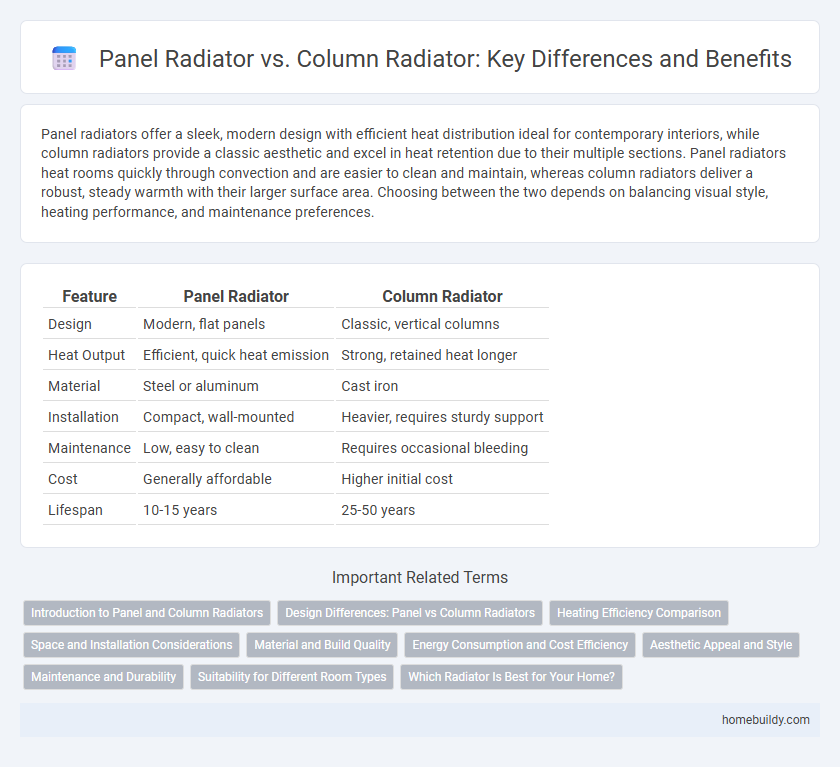Panel radiators offer a sleek, modern design with efficient heat distribution ideal for contemporary interiors, while column radiators provide a classic aesthetic and excel in heat retention due to their multiple sections. Panel radiators heat rooms quickly through convection and are easier to clean and maintain, whereas column radiators deliver a robust, steady warmth with their larger surface area. Choosing between the two depends on balancing visual style, heating performance, and maintenance preferences.
Table of Comparison
| Feature | Panel Radiator | Column Radiator |
|---|---|---|
| Design | Modern, flat panels | Classic, vertical columns |
| Heat Output | Efficient, quick heat emission | Strong, retained heat longer |
| Material | Steel or aluminum | Cast iron |
| Installation | Compact, wall-mounted | Heavier, requires sturdy support |
| Maintenance | Low, easy to clean | Requires occasional bleeding |
| Cost | Generally affordable | Higher initial cost |
| Lifespan | 10-15 years | 25-50 years |
Introduction to Panel and Column Radiators
Panel radiators feature flat, smooth surfaces designed for efficient heat distribution through convection and radiation, often made from steel or aluminum for rapid warming. Column radiators consist of vertical sections that create multiple columns, enabling large surface areas for superior heat retention and classic aesthetic appeal. Both types serve heating purposes but differ primarily in design, heating efficiency, and installation preferences in residential or commercial spaces.
Design Differences: Panel vs Column Radiators
Panel radiators feature a sleek, flat-front design with one or more smooth panels, offering a modern and minimalist aesthetic ideal for contemporary interiors. Column radiators consist of multiple vertical columns with a classic, industrial look, providing more surface area for heat emission and adding a vintage charm to rooms. The design differences directly impact heating efficiency and visual appeal, making panel radiators suited for streamlined spaces and column radiators preferred in traditional or rustic settings.
Heating Efficiency Comparison
Panel radiators deliver faster heat transfer due to their large flat surfaces that emit radiant heat efficiently, making them ideal for quick room warming. Column radiators excel in thermal inertia, retaining heat longer after the heating source is turned off, which is beneficial for sustained warmth and energy savings. Studies show panel radiators have higher immediate heating output measured in BTUs, while column radiators provide more consistent heat distribution over time.
Space and Installation Considerations
Panel radiators feature a slim profile ideal for compact spaces, enabling installation close to walls with minimal projection into the room, which maximizes usable space. Column radiators, while bulkier due to their multiple vertical sections, provide strong heat output but require more clearance from walls for proper airflow and maintenance, potentially limiting placement options. Installation of panel radiators is generally more straightforward and suitable for modern interiors, whereas column radiators may demand more robust mounting and additional support due to their weight and size.
Material and Build Quality
Panel radiators typically feature smooth steel panels that offer sleek aesthetics and efficient heat conduction, contributing to faster warming of spaces. Column radiators are commonly constructed from cast iron or steel, providing superior heat retention and durability due to their robust segmented design. The material density and build of column radiators generally result in longer-lasting performance and better heat distribution compared to the thinner, lighter panel radiators.
Energy Consumption and Cost Efficiency
Panel radiators typically offer superior energy efficiency due to their larger surface area and faster heat transfer, reducing heating costs over time. Column radiators, while often more cost-effective initially, may consume more energy because of slower heat distribution and retained heat. Choosing panel radiators can result in long-term savings by optimizing energy consumption and maximizing cost efficiency.
Aesthetic Appeal and Style
Panel radiators offer a sleek, minimalist design that seamlessly integrates with modern interiors, featuring flat surfaces and clean lines that complement contemporary decor. Column radiators provide a classic, vintage aesthetic with their rounded, vertical sections, adding architectural interest and a sense of traditional charm to any room. The choice between them depends on desired style coherence: panel radiators suit streamlined, modern spaces, while column radiators enhance period or eclectic interiors with their ornamental appeal.
Maintenance and Durability
Panel radiators feature a smooth surface that facilitates easy cleaning and minimal dust accumulation, enhancing maintenance efficiency. Column radiators, constructed from cast iron or steel columns, offer superior durability due to their robust build and resilience to corrosion over time. Regular bleeding and inspection are critical for both types, but column radiators generally require less frequent maintenance given their sturdy design and long lifespan.
Suitability for Different Room Types
Panel radiators are ideal for modern living spaces and smaller rooms due to their sleek design and efficient heat distribution, fitting neatly against walls without taking up much space. Column radiators suit larger rooms or period properties where a classic aesthetic and higher heat output are essential, as their multi-column design maximizes surface area for better warmth. Choosing between panel and column radiators depends on room dimensions, insulation quality, and desired visual impact.
Which Radiator Is Best for Your Home?
Panel radiators offer sleek designs and faster heat distribution, making them ideal for modern homes with limited space. Column radiators, known for their robust heat output and vintage aesthetic, suit larger rooms and traditional interiors. Choosing the best radiator depends on room size, heat requirements, and interior style preferences.
Panel Radiator vs Column Radiator Infographic

 homebuildy.com
homebuildy.com